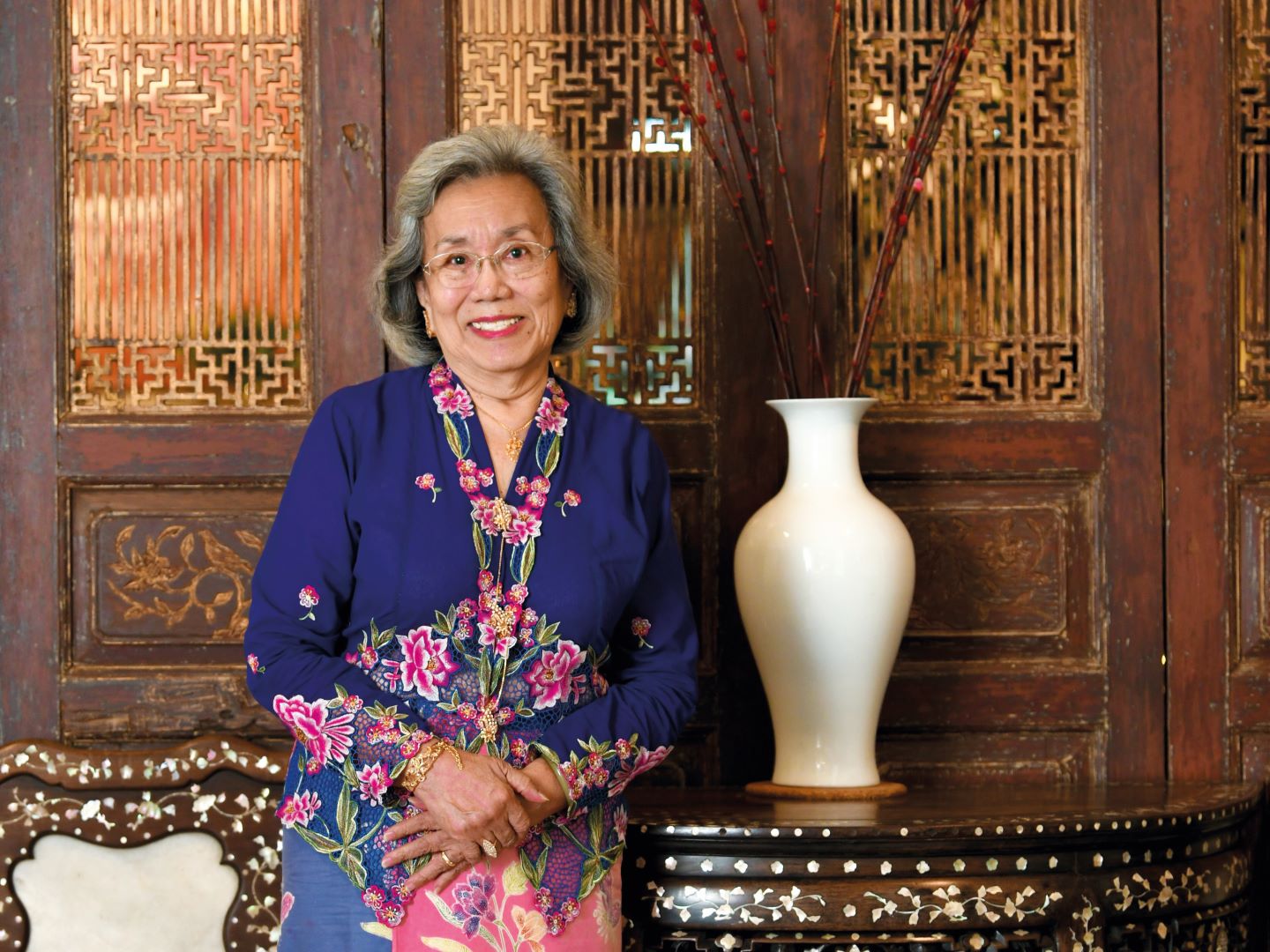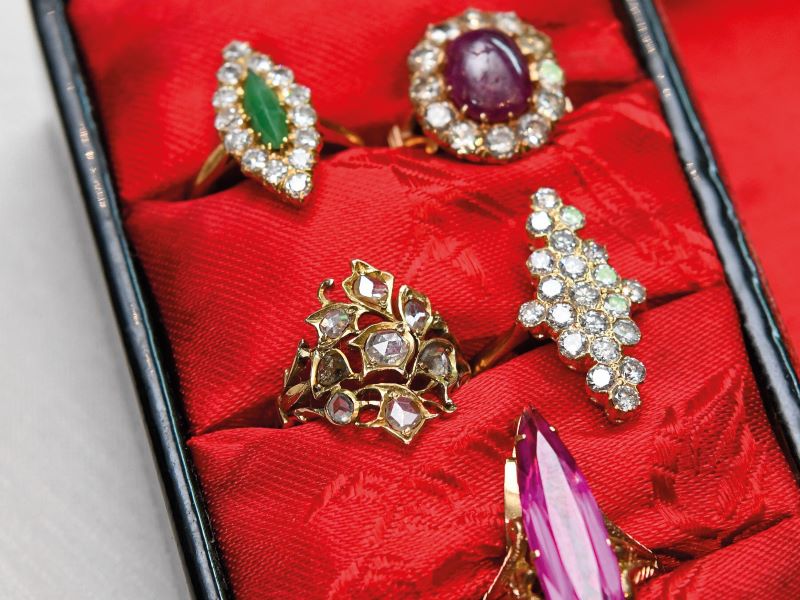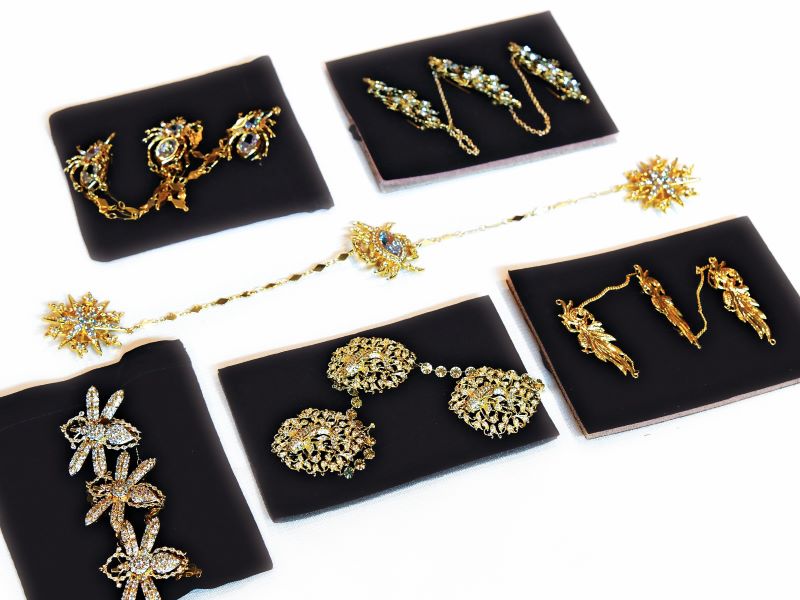
Yew: I have so many stories to tell. If I don’t, they will die with me (All photos: Low Yen Yeing/The Edge Malaysia)
Tell Lily Yew that you have old Nyonya jewellery and she will say, “Take them out and wear them!” Because if you keep them tucked away for too long, they may start to lose their shine. More than just treasuring these precious pieces, one should flaunt their intricate handiwork and the motifs of flora, fauna and celestial creatures tied to the traditions and rituals of the Peranakans, she thinks.
Yew, née Lim Chooi Lian, who comes from a long line of Penang Straits Chinese, grew up wearing Nyonya jewellery and has been collecting these since buying her first piece, a kerongsang (string of three brooches attached to a chain), for RM280 in the early 1970s — her month’s salary then. She delights in matching vintage creations with kebaya, colourful pairings that often prompt questions from those she meets.
“I have so many stories to tell. If I don’t, they will die with me. I will share them with anyone who wants to know. I believe I have the knowledge and experience,” says the 76-year-old, who will be giving tea talks on the “Nyonya & Her Jewellery” in Kuala Lumpur on Sept 29 and Oct 20.
As guests sip tea and savour Peranakan treats, she will go into details on who are the Straits Chinese, what is Nyonya jewellery, materials used to fashion them (there is a difference between berlian and intan) and their designs — peacocks, sparrows, roosters and the phoenix are inspirations, as are fish, fruits, butterflies, dragonflies, flowers, crowns and baskets.
Yew will bring out pieces to show as she tells, from pendants and brooches to bangles, buttons and belts, earrings, rings, cucuk sanggul (hairpins) and, of course, the kerongsang, and share how best to care for them, whether they are made of diamonds, rubies, rhinestones, gold, silver or suasa (a mix of gold and copper), their quality and setting. Her vignettes of growing up surrounded by Nyonyas who wore jewellery daily and specific items for different occasions are bound to keep listeners agog.
20240906_peo_madam_lily_nyonya_jewellery_39_lyy.jpg

The rich would buy diamonds in bags from Ceylonese craftsmen who came to their homes bearing moulded designs and toolboxes. “They would sit in front of you and you chose what you wanted. Then they would set the stones before you. You had to watch them to make sure they didn’t tuck little stones into their ears or nose. My Ah Kong had four daughters and if he wanted earrings for them, they would end up having almost identical pieces,” she recalls. Babies were given anklets at birth but girls stopped wearing them after puberty because the accessory was associated with ladies of the night “advertising” their service. Nyonyas had special sets of jewellery reserved for wakes, funerals and during the mourning period, which lasted three years for traditional families. Elaborate and more colourful pieces were brought out for festive occasions, especially weddings, and brides would be decked out from head to toe in multiple heavy items.
“These are all real but what people don’t understand is that they may not belong to the family. Often, they are on loan from relatives and friends. This is what kinship is all about — we trust each other and we know the pieces will come back. Your daughter is getting married and we are happy for you. So, we let the bride use our jewellery.
“And when our daughters leave the house, they go fully decked and loaded so they won’t be bullied. Their in-laws know they can go home anytime.”
Old Nyonyas are known to be a formidable lot and practical too. Yew’s maternal grandmother was famous for washing her jewellery and putting them out to sun on a bamboo tray at her house in Muntri Street, George Town.
“That was how it was done because anything kept too long will become very dull — there’s no life. So, you need to wear it.”
How? Repurpose vintage jewellery to suit modern attire, Yew suggests. The kerongsang can be taken apart and worn separately as three brooches. A necklace can serves as a stunning headpiece while a silver belt draped around the hip instantly jazzes up a plain dress or blouse. Chunky pendants tucked into combed up hair become statement pieces to show off the skill of artisans who worked to please exacting matriarchs who knew the intrinsic value of quality jewellery.
20240906_peo_madam_lily_nyonya_jewellery_50_lyy.jpg

Ultimately, Yew’s plea to those who own Nyonya jewellery but have no idea what to do with them is: “Don’t melt them down because they will be gone forever. They are our heritage and we should keep the traditions they represent alive. If you want to buy reproductions of traditional pieces, I will tell you where to find them. If you want to sell, tell us,” says this collector who works with a company that produces costume jewellery based on vintage designs. She is also a kebaya and batik entrepreneur.
Now that she has started to help preserve the beauty of vintage jewellery and promote its use, she wants to do more. Yew is working on a book about the Peranakan garden, together with Julie Wong, a journalist and food writer who has turned to writing books about heritage, culture and cuisine.
“I’m doing this to honour my grandfather, who was a gentleman gardener. Peranakan gardens start in the courtyard of the home and often extend to the back part of house. We may grow a plant here and there and pluck whatever we need for cooking, from lengkuas to daun pandan and limau purut. I can teach you how to use every part of a coconut tree, from its leaves to the trunk, fruit and flower, and coconut water.”
‘Nyonya & Her Jewellery’ will be held at Warong Old China, 144 Jalan Tun H S Lee, KL, on Oct 20 at 3pm. To register, contact (016) 375 3868.
This article first appeared on Sept 16, 2024 in The Edge Malaysia.


